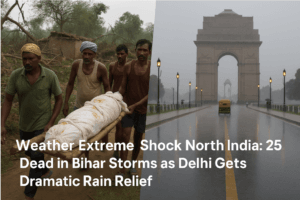Weather Extremes Shock North India: 25 Dead in Bihar Storms as Delhi Gets Dramatic Rain Relief
Northern India grapples with contrasting weather extremes as deadly storms claim 25 lives in Bihar while Delhi welcomes rain-driven relief from scorching heat. Lightning strikes and hailstorms battered Bihar this week, with Nalanda district reporting 18 fatalities, prompting state compensation for victims’ families. Meanwhile, Delhi’s temperatures dipped slightly after hitting 40.9°C earlier, with thunderstorms and light rain forecast through Saturday, though the IMD warns of potential power disruptions and uprooted trees.
While the capital’s residents find respite, Bihar’s rural communities face recurring climate vulnerabilities, exacerbated by limited access to real-time weather alerts and storm shelters. Experts highlight rising pre-monsoon heatwaves and erratic storms as signs of shifting climate patterns, stressing the need for improved disaster preparedness. Delhi’s Safdarjung station recorded a 39.6°C peak this week—4.5°C above normal—underscoring prolonged summer risks.
As Bihar braces for more rain, the tragedy spotlights India’s uneven battle against climate-driven disasters, where urban relief contrasts sharply with rural crises.

Weather Extremes Shock North India: 25 Dead in Bihar Storms as Delhi Gets Dramatic Rain Relief
As contrasting weather patterns swept across North India this week, Delhi welcomed rain-driven relief from scorching temperatures while Bihar faced tragedy with at least 25 lives lost to lightning strikes and severe storms.
Delhi’s Heatwave Break: Thunderstorms Bring Respite
After days of oppressive heat pushing temperatures above 40°C (104°F), Delhi residents awoke to cloudy skies and unexpected drizzle on Thursday. Key areas like India Gate and Kartavya Path saw sudden showers, though the Ridge and Ayanagar stations still recorded highs of 40.9°C and 40.2°C, respectively. Safdarjung, Delhi’s primary weather station, noted a peak of 39.6°C—4.5°C above seasonal norms.
Weekend Forecast
- Friday & Saturday: Cloudy skies with thunderstorms, light rain, and gusty winds (30–40 km/h). The IMD warns of possible power outages, fallen trees, and traffic disruptions.
- Sunday–Monday: Cloud cover persists, but storms ease.
- Next Week: Strong surface winds expected from April 16.
Authorities urged caution near power lines and water bodies, advising commuters to check routes for delays. The sudden shift highlights Delhi’s volatile spring weather, where heatwaves and storms often collide.
Bihar’s Lightning Tragedy: Climate Vulnerabilities Exposed
Bihar faced devastation as thunderstorms and hailstorms claimed 25 lives on Thursday, primarily in Nalanda (18 deaths). Other affected districts included Siwan, Katihar, and Darbhanga. This follows 13 lightning-related deaths earlier in the week. Opposition leader Tejashwi Yadav disputed official figures, claiming over 50 fatalities.
Why Lightning Strikes Are Frequent in Bihar
- Geographical Factors: Flat terrain and high humidity create ideal conditions for thunderstorms.
- Agricultural Risks: Farmers working outdoors during pre-monsoon months (April–June) are especially vulnerable.
- Infrastructure Gaps: Limited access to weather alerts and storm shelters exacerbates risks.
The state government announced ₹4 lakh compensation for victims’ families, while the IMD issued alerts for heavy rain in 15 districts through Saturday.
Human Cost of Erratic Weather
These events underscore India’s growing climate challenges:
- Urban Heat vs. Rural Vulnerability: While Delhi’s rain brought temporary relief, Bihar’s rural poor faced lethal consequences.
- Early Heatwaves: Rising pre-monsoon temperatures (Delhi hit 40.9°C this week) strain health systems and energy grids.
- Need for Preparedness: Enhanced weather forecasting, public awareness campaigns, and storm-resistant infrastructure are critical.
Staying Safe During Thunderstorms
- Outdoor Safety: Avoid open fields, tall trees, and metal objects.
- Indoor Precautions: Unplug electronics, stay away from windows.
- Stay Informed: Track real-time IMD alerts via mobile apps or local news.
As climate patterns grow more unpredictable, balancing urban adaptability with rural resilience remains India’s pressing challenge. For now, Delhi’s brief cool spell offers a fleeting respite, while Bihar mourns lives lost to nature’s fury.
You must be logged in to post a comment.